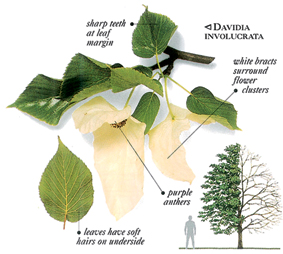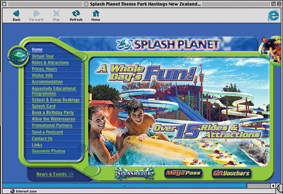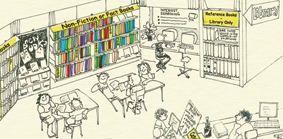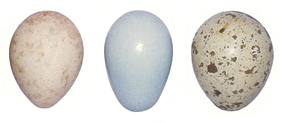
The Project
directors acknowledge the vital support and contributions of many
people to this report, including:
 •
the very dedicated staff of the Educational Assessment Research
Unit •
the very dedicated staff of the Educational Assessment Research
Unit
• Stephen Porteners and other staff members of the Ministry
of Education
• members of the Project’s National Advisory Committee
• members of the Project’s Information Skills Advisory
Panel
• principals and children of the schools where tasks were
trialled
• principals, staff and Board of Trustee members of the 248
schools included in the 2005 sample
• the 2879 children who participated in the assessments and
their parents
• the 96 teachers who administered the assessments to the
children
• the 44 senior tertiary students who assisted with the marking
process
• the 172 teachers who assisted with the marking of tasks
early in 2006.

New Zealand’s
National Education Monitoring Project commenced in 1993, with the
task of assessing and reporting on the achievement of New Zealand
primary school children in all areas of the school curriculum. Children
are assessed at two class levels: year 4 (halfway through primary
education) and year 8 (at the end of primary education). Different
curriculum areas and skills are assessed each year, over a four-year
cycle. The main goal of national monitoring is to provide detailed
information about what children can do so that patterns of performance
can be recognised, successes celebrated, and desirable changes to
educational practices and resources identified and implemented.
Each year, small random samples of children are selected nationally,
then assessed in their own schools by teachers specially seconded
and trained for this work. Task instructions are given orally by
teachers, through video presentations, on laptop computers, or in
writing. Many of the assessment tasks involve the children in the
use of equipment and supplies. Their responses are presented orally,
by demonstration, in writing, in computer files, or through submission
of other physical products. Many of the responses are recorded on
videotape for subsequent analysis.
The use of many tasks with both year 4 and year 8 students allows
comparisons of the performance of year 4 and 8 students in 2005.
Because some tasks have been used twice, in 2001 and again in 2005,
trends in performance across the four-year period can also be analysed.
In 2005, the third year of the third cycle of national monitoring,
three areas were assessed: mathematics, social studies and information
skills. This report presents details and results of the assessments
of information skills.
 |
Chapter
2 explains the place of information skills in the
New Zealand curriculum and presents the framework for information
skills. This identified three main content areas or strands:
clarifying information needs, finding and gathering information,
and analysing and using information. Within each of these
areas, various strategies, skills and processes were identified.
The importance of attitudes and motivation was also noted. |
| CLARIFYING
INFORMATION NEEDS |
|
Chapter
3
presents information about students’ skills in clarifying
information needs based on 11 assessment tasks. Year 8 students
enjoyed more success than year 4 students. Averaged across
43 task components attempted by both years, 14 percent more
year 8 than year 4 students succeeded well with these components.
Averaged across nine trend task components attempted by year
4 students in both 2001 and 2005, three percent fewer students
succeeded in 2005 than in 2001. This is a small decrease.
At year 8 level, again with nine components included, on average
there was no change between 2001 and 2005. Both of these trend
results should be interpreted cautiously because they are
based on just nine components of two trend tasks. |
| FINDING
AND GATHERING INFORMATION |
| Chapter
4 presents results for 24 tasks that involved finding
and gathering information. Year 8 students enjoyed substantially
more success than year 4 students. Averaged across 52 components
of eight tasks attempted by both years, 23 percent more year
8 than year 4 students succeeded well with these components.
Year 8 students scored higher on all 52 components.
Averaged across 25 components of two trend tasks attempted
by year 4 students in both 2001 and 2005, one percent fewer
students succeeded in 2005 than in 2001. This is a negligible
decrease. At year 8 level, with 68 components of four trend
tasks included, on average three percent more students succeeded
in 2005. This is a small increase. |
 |
| ANALYSING
AND USING INFORMATION |
|
 |
Chapter
5
presents results for 16 tasks that asked students to analyse
and use information. Year 8 students enjoyed substantially
more success than year 4 students. Averaged across 84 components
of 11 tasks attempted by both years, 17 percent more year
8 than year 4 students succeeded well with these components.
Averaged across seven components of two trend tasks attempted
by year 4 students in both 2001 and 2005, one percent fewer
students succeeded in 2005 than in 2001. This is a negligible
decrease, based on a small sample of tasks and components.
At year 8 level, with 25 components of four tasks included,
on average two percent fewer students succeeded in 2005. This
decrease is also too small to be regarded as meaningful. |
|
Overall
trends can be assessed by considering all 12 trend tasks from
Chapters 3 to 5. For year 4 students, based on 41 components
of six trend tasks, on average one percent fewer students
than in 2001 succeeded with the task components in 2005. For
year 8 students, based on 101 components of 10 trend tasks,
one percent more students than in 2001 succeeded with the
task components in 2005. Both of these trends are too small
to be meaningful. |
|
INFORMATION SKILLS SURVEY |
 Chapter
6
focuses on the results of a survey that sought information from
students about their strategies for, involvement in, and enjoyment
of information gathering and interpreting activities. For both year
4 and year 8 students in 2005, the internet was by a substantial
margin the most popular source of information, with a significant
increase since 2001 both overall and relative to other sources such
as libraries. A substantially greater proportion of year 8 than
year 4 students reported that they had to find information for a
project or topic heaps or quite a lot. Perhaps as a consequence
of being given such tasks more frequently, year 8 students were
much less inclined than year 4 students to be enthusiastic about
hunting for information and about writing down the information they
found. While year 4 students responded similarly to questions 1
and 2, the pattern was quite different for year 8 students, suggesting
that many of the information-finding projects which year 8 students
were asked to attempt were not viewed as “really interesting”.
Most students are quite happy to share with others the information
they have found. Only about 40 percent of students at both year
levels report having used a library catalogue heaps or quite a lot.
Where comparisons with 1997 and 2001 responses are possible, the
results in 2005 appear to be very similar. Chapter
6
focuses on the results of a survey that sought information from
students about their strategies for, involvement in, and enjoyment
of information gathering and interpreting activities. For both year
4 and year 8 students in 2005, the internet was by a substantial
margin the most popular source of information, with a significant
increase since 2001 both overall and relative to other sources such
as libraries. A substantially greater proportion of year 8 than
year 4 students reported that they had to find information for a
project or topic heaps or quite a lot. Perhaps as a consequence
of being given such tasks more frequently, year 8 students were
much less inclined than year 4 students to be enthusiastic about
hunting for information and about writing down the information they
found. While year 4 students responded similarly to questions 1
and 2, the pattern was quite different for year 8 students, suggesting
that many of the information-finding projects which year 8 students
were asked to attempt were not viewed as “really interesting”.
Most students are quite happy to share with others the information
they have found. Only about 40 percent of students at both year
levels report having used a library catalogue heaps or quite a lot.
Where comparisons with 1997 and 2001 responses are possible, the
results in 2005 appear to be very similar.
Chapter
7 details the results of analyses comparing the performance
of different demographic subgroups. School type (full primary, intermediate,
or year 7 to 13 high school), school size, community size and geographic
zone did not seem to be important factors predicting achievement
on the information skills tasks. The same was true for the 2001
and 1997 assessments. However, there were statistically significant
differences in the performance of students from low, medium and
high decile schools on 57 percent of the tasks at year 4 level (compared
to 43 percent in 2001 and 81 percent in 1997) and 54 percent of
the tasks at year 8 level (compared to 71 percent in 2001 and 56
percent in 1997).
For the comparisons of boys with girls, Pakeha with Mäori,
Pakeha with Pasifika students, and students for whom the predominant
language at home was English with those for whom it was not, effect
sizes were used. Effect size is the difference in mean (average)
performance of the two groups, divided by the pooled standard deviation
of the scores on the particular task. For this summary, these effect
sizes were averaged across all tasks.
Year 4 girls averaged slightly higher than boys, with a mean effect
size of 0.14 (compared to 0.06 in 2001). Year 8 girls averaged moderately
higher than boys, with a mean effect size of 0.27 (compared to 0.15
in 2001). As was also true in 2001, the information skills survey
results at both year levels showed some evidence that girls were
more positive than boys about information skills activities.
Pakeha students averaged moderately higher than Mäori students,
with mean effect sizes of 0.36 for year 4 students and 0.27 for
year 8 students (the corresponding figures in 2001 were 0.25 and
0.39).
 Year 4 Pakeha students averaged moderately higher than Pasifika
students, with a mean effect size of 0.37 (compared to 0.40 in 2001).
Year 8 Pakeha students averaged substantially higher than Pasifika
students, with a mean effect size of 0.48 (compared to 0.46 in 2001).
The information skills survey results showed that Pasifika students
were more involved in and enthusiastic about some aspects of information
skills.
Year 4 Pakeha students averaged moderately higher than Pasifika
students, with a mean effect size of 0.37 (compared to 0.40 in 2001).
Year 8 Pakeha students averaged substantially higher than Pasifika
students, with a mean effect size of 0.48 (compared to 0.46 in 2001).
The information skills survey results showed that Pasifika students
were more involved in and enthusiastic about some aspects of information
skills.
Compared to students for whom the predominant language at home was
English, students from homes where other languages predominated
averaged slightly lower, with mean effect sizes of 0.16 for year
4 students and 0.18 for year 8 students. Comparative figures are
not available for the assessments in 2001.
|
 •
the very dedicated staff of the Educational Assessment Research
Unit
•
the very dedicated staff of the Educational Assessment Research
Unit


 Chapter
6
focuses on the results of a survey that sought information from
students about their strategies for, involvement in, and enjoyment
of information gathering and interpreting activities. For both year
4 and year 8 students in 2005, the internet was by a substantial
margin the most popular source of information, with a significant
increase since 2001 both overall and relative to other sources such
as libraries. A substantially greater proportion of year 8 than
year 4 students reported that they had to find information for a
project or topic heaps or quite a lot. Perhaps as a consequence
of being given such tasks more frequently, year 8 students were
much less inclined than year 4 students to be enthusiastic about
hunting for information and about writing down the information they
found. While year 4 students responded similarly to questions 1
and 2, the pattern was quite different for year 8 students, suggesting
that many of the information-finding projects which year 8 students
were asked to attempt were not viewed as “really interesting”.
Most students are quite happy to share with others the information
they have found. Only about 40 percent of students at both year
levels report having used a library catalogue heaps or quite a lot.
Where comparisons with 1997 and 2001 responses are possible, the
results in 2005 appear to be very similar.
Chapter
6
focuses on the results of a survey that sought information from
students about their strategies for, involvement in, and enjoyment
of information gathering and interpreting activities. For both year
4 and year 8 students in 2005, the internet was by a substantial
margin the most popular source of information, with a significant
increase since 2001 both overall and relative to other sources such
as libraries. A substantially greater proportion of year 8 than
year 4 students reported that they had to find information for a
project or topic heaps or quite a lot. Perhaps as a consequence
of being given such tasks more frequently, year 8 students were
much less inclined than year 4 students to be enthusiastic about
hunting for information and about writing down the information they
found. While year 4 students responded similarly to questions 1
and 2, the pattern was quite different for year 8 students, suggesting
that many of the information-finding projects which year 8 students
were asked to attempt were not viewed as “really interesting”.
Most students are quite happy to share with others the information
they have found. Only about 40 percent of students at both year
levels report having used a library catalogue heaps or quite a lot.
Where comparisons with 1997 and 2001 responses are possible, the
results in 2005 appear to be very similar. Year 4 Pakeha students averaged moderately higher than Pasifika
students, with a mean effect size of 0.37 (compared to 0.40 in 2001).
Year 8 Pakeha students averaged substantially higher than Pasifika
students, with a mean effect size of 0.48 (compared to 0.46 in 2001).
The information skills survey results showed that Pasifika students
were more involved in and enthusiastic about some aspects of information
skills.
Year 4 Pakeha students averaged moderately higher than Pasifika
students, with a mean effect size of 0.37 (compared to 0.40 in 2001).
Year 8 Pakeha students averaged substantially higher than Pasifika
students, with a mean effect size of 0.48 (compared to 0.46 in 2001).
The information skills survey results showed that Pasifika students
were more involved in and enthusiastic about some aspects of information
skills.